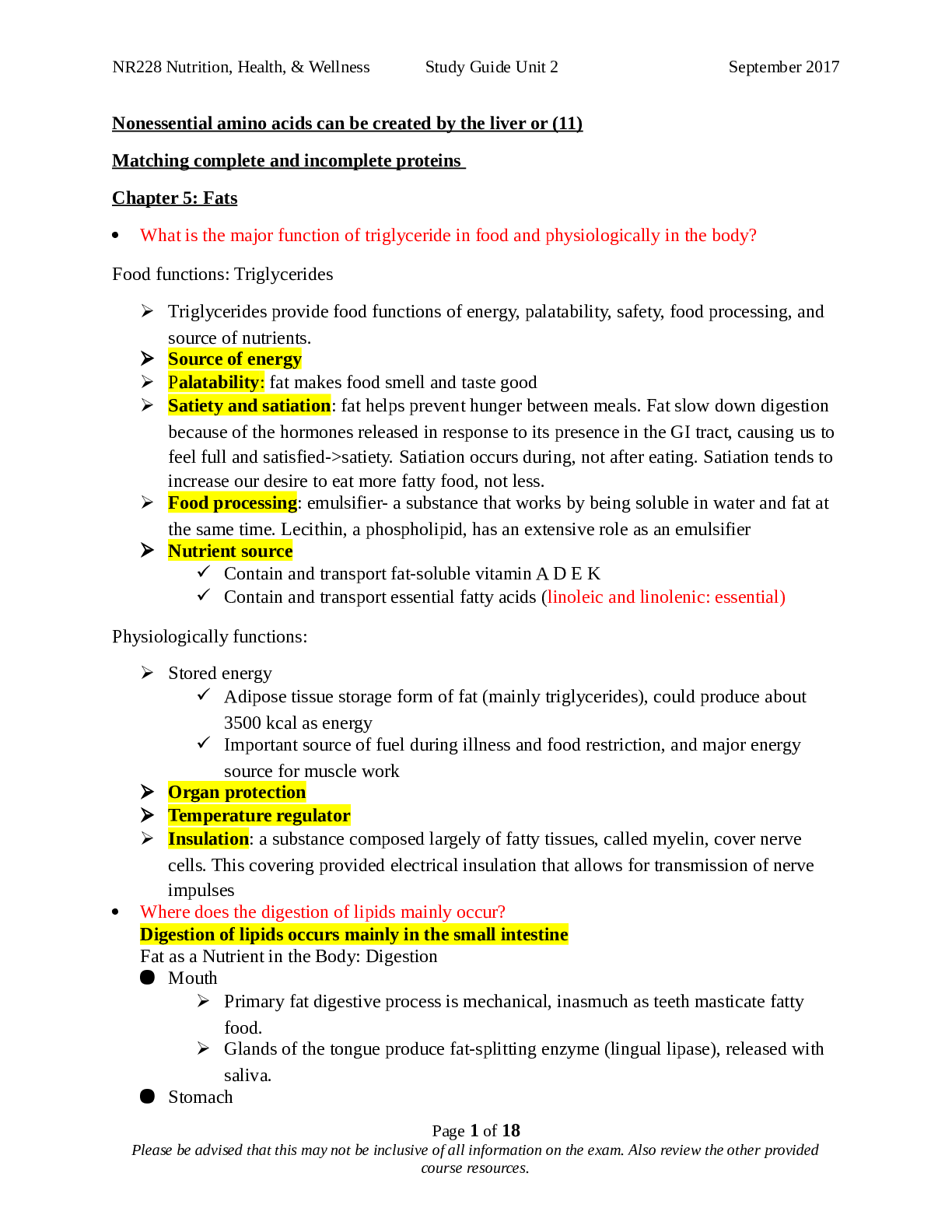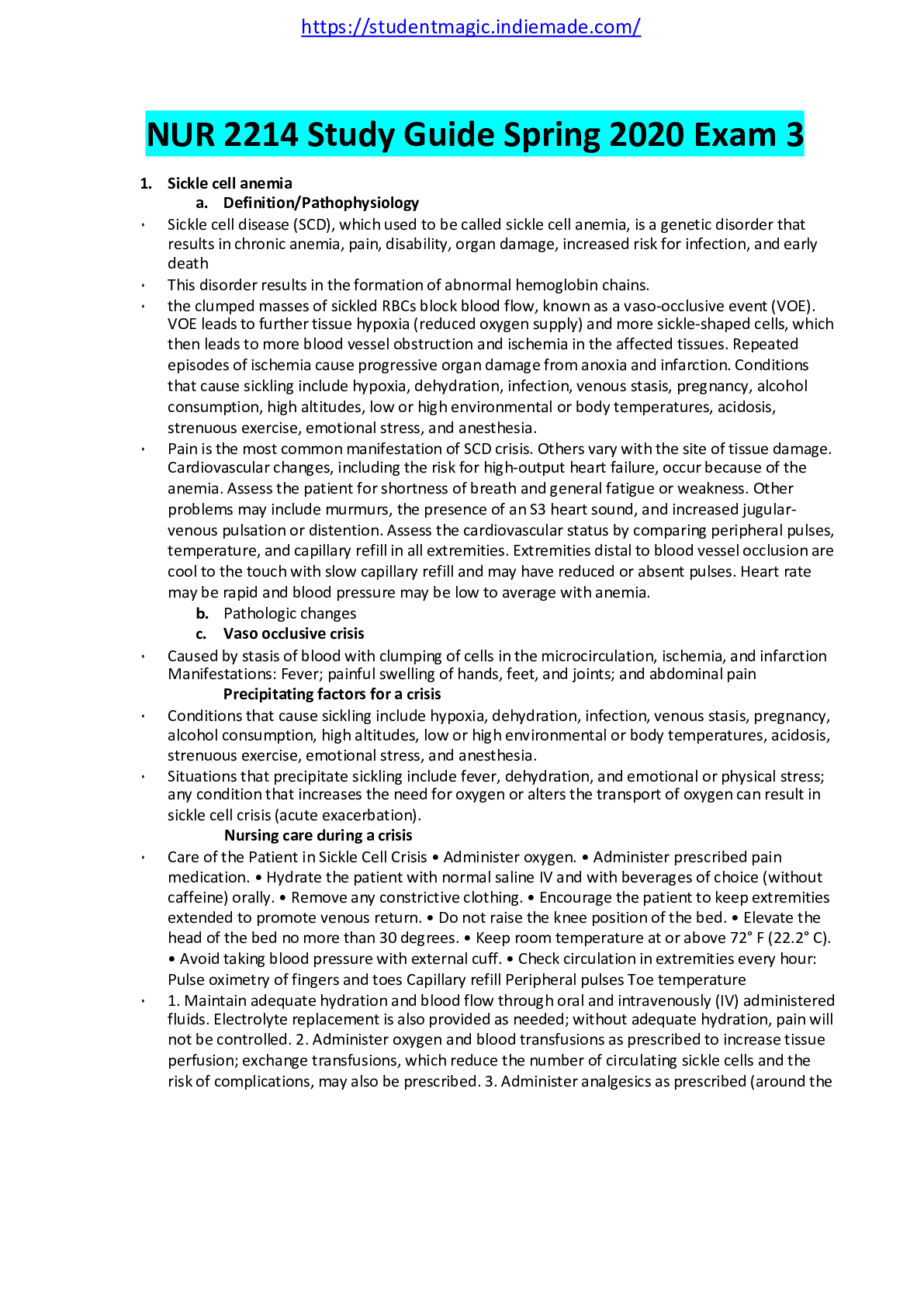*NURSING > STUDY GUIDE > NSG6005 Test Questions Test Prep CH 17-23 (100% Correct answers featured in the Test Prep doc) (All)
NSG6005 Test Questions Test Prep CH 17-23 (100% Correct answers featured in the Test Prep doc)
Document Content and Description Below
NSG6005 Test Questions Test Prep CH 17-23 Ch. 17 1. The nurse is preparing to administer enteral nutrition to a patient. Which assessment finding would prompt the nurse to hold the nutrition and... notify the patient’s provider? 2. The nurse is preparing to administer an enteral feeding to a patient who receives 300 mL of Isocal over 30 minutes every 4 hours. The nurse checks the residual prior to initiating the feeding and notes a residual amount of 50 mL of formula. Which action will the nurse take next? 3. The provider calculates the enteral nutrition needs for a nonambulatory patient and determines that the patient will need 300 mL of Ultracal every 4 hours. Which method of delivery will the nurse use to administer 4. The nurse is preparing a patient who will receive intermittent enteral nutrition at home with a hyperosmolar solution. What information will the nurse include when teaching this patien 5. The nurse assumes care of a patient who has been receiving intermittent enteral feedings of 240 mL of Osmolite every 4 hours for the past 48 hours. The patient is in bed with the head of the bed elevated 60 degrees. The enteral tubing is intact, and the enteral pump is infusing at 360 mL per hour. The nurse notes 60 mL of solution left in the bag. The tubing is not labeled. What will the nurse do? 6. The nurse dilutes an antibiotic before administering it through a patient’s nasogastric tube. The patient asks why this is necessary. The nurse explains that diluting the antibiotic helps to 7. The nurse is caring for a patient who is receiving total parenteral nutrition (TPN). The nurse will carefully monitor this patient for which symptom(s)? 8. The nurse is preparing to hang a new bag for a patient who is receiving total parenteral nutrition (TPN). During this procedure, the nurse will instruct the patient to take a deep breath and then perform which action? 9. Which patient is most likely to be a candidate for total parenteral nutrition (TPN) rather than enteral nutrition? 10. The nurse is preparing to administer enteral nutrition to a patient who has had a stroke and who cannot swallow. A family member asks why the patient isn’t receiving intravenous nutrition. What information will the nurse provide to the family member? 11. A patient who has been receiving continuous enteral nutrition has had several large, watery stools. The nurse will contact the provider to discuss which intervention? 12. A patient who has been receiving total parenteral nutrition (TPN) for several days accidently removes the intravenous (IV) line. While waiting for the IV therapy nurse, the nurse caring for this patient will monitor for which complication? 13. The nurse is preparing to discontinue total parenteral nutrition (TPN) therapy for a patient who has been receiving TPN for several days. The nurse will contact the provider to discuss an order for 14. The nurse is caring for a patient with severe burns who will begin receiving total parenteral nutrition (TPN). The patient asks why TPN is necessary. The nurse explains that TPN is used for which reason? 15. The nurse is caring for an adult with severe burns who weighs 60 kg. Prior to initiating total parenteral nutrition (TPN) therapy, the nurse reviews the orders. Which TPN order is correct for this patient? 16. The nurse is caring for a patient who is receiving total parenteral nutrition (TPN). The patient reports nausea, headache, and thirst. The nurse will contact the provider to discuss 17. The nurse is caring for a patient who is receiving total parenteral nutrition (TPN) and notes that the patient becomes dyspneic when transferring from the bed to a chair. The nurse auscultates rales in both lungs. Which action will the nurse take next? 18. The nurse is caring for a patient who is being treated with total parenteral nutrition (TPN). The patient is experiencing chest pain, and the nurse observes shortness of breath and coughing along with cyanosis. The nurse understands that this patient is most likely experiencing which condition? 19. A patient receiving total parenteral nutrition (TPN) begins having cough and dyspnea. The nurse auscultates rales and notes neck vein engorgement and weight gain. The nurse suspects that the patient is experiencing which condition? 20. The nurse assumes care for a patient who is being treated with enteral feeding. When performing the initial assessment, the nurse finds the patient supine and asleep. The nurse will perform which action? MULTIPLE RESPONSE 1. Patients with which conditions would benefit from enteral feedings? (Select all that apply.) a. Burns of face, chest, and neck Chapter 18: Adrenergic Agonists and Adrenergic Blockers 1. The nurse is caring for a patient who has asthma and administers a selective beta2-adrenergic agonist to treat bronchospasm. The nurse will expect this drug to also cause which side effect? 2. A patient who has asthma is diagnosed with hypertension. The nurse understands that which drug will be safe to give this patient? 3. The nurse administers subcutaneous epinephrine to a patient who is experiencing an anaphylactic reaction. The nurse should expect to monitor the patient for which symptom? 4. An adult patient is brought to the emergency department for treatment of an asthma exacerbation. The patient uses inhaled albuterol as needed to control wheezing. The nurse notes expiratory wheezing, tremors, restlessness, and a heart rate of 120 beats per minute. The nurse suspects that the patient has 5. The nurse is caring for a patient who is receiving intravenous dopamine (Intropin). The nurse notes erythema and swelling at the IV insertion site. What is the nurse’s initial action? 6. The nurse is teaching a patient how to use phenylephrine HCl (Neo-Synephrine) nasal spray to treat congestion from a viral upper respiratory infection. What instruction will the nurse give the patient? 7. The nurse is caring for a patient who will begin taking atenolol (Tenormin). What information will the nurse include when teaching the patient about taking this medication? 8. The nurse is caring for a patient who has recently begun taking atenolol (Tenormin) to treat hypertension. The patient reports dizziness, nausea, vomiting, and decreased libido since beginning the medication. What will the nurse do? 9. A patient will begin taking albuterol (Proventil) to treat asthma. When teaching the patient about this drug, the nurse will make which recommendation? 10. A patient is taking doxazosin mesylate (Cardura) 1 mg per day to treat hypertension. The nurse notes a blood pressure of 110/72 mm Hg and a heart rate of 92 beats per minute. The nurse will contact the provider to discuss which change to the drug regimen? 11. A patient who has Raynaud’s disease will begin taking an alpha-adrenergic blocker. The patient asks the nurse how the drug works to treat symptoms. The nurse explains that alpha-adrenergic blockers treat Raynaud’s disease by causing 12. A nurse is teaching a patient how to use phenylephrine (Neo-Synephrine) nasal spray. To avoid systemic absorption, the nurse teaches the patient to perform which action? 13. A patient will be discharged on beta blockers. Which skill is essential for the nurse to teach the patient’s family? 14. The nurse is caring for a patient whose provider has just ordered a switch from atenolol (Tenormin) to reserpine. When preparing the patient to take this medication, what will the nurse do? 15. The patient has been started on a treatment regimen that includes atenolol (Tenormin) and complains to the nurse of feeling weak. Which is the best response from the nurse? 16. The nurse is performing an admission assessment on a patient who has recently begun taking reserpine. The patient reports using St. John’s wort. The nurse anticipates that the patient will have 17. The patient has been ordered to receive Sudafed to treat nasal congestion. The nurse performing an admission assessment learns that the patient has diabetes mellitus. What action is appropriate for the nurse to take? MULTIPLE RESPONSE 1. The nurse caring for a patient who is taking an adrenergic agent will expect which side effects? (Select all that apply.) Chapter 19: Cholinergic Agonists and Anticholinergics MULTIPLE CHOICE 1. The nurse is preparing to administer a drug and learns that it is an indirect-acting cholinergic agonist. The nurse understands that this drug 2. A nursing student asks why a direct-acting cholinergic agonist drug that is selective to muscarinic receptors is described as being non-specific. The nurse will explain that this is because 3. The nurse is preparing to administer bethanechol (Urecholine) to a patient who is experiencing urinary retention. The nurse notes that the patient has a blood pressure of 90/60 mm Hg and a heart rate of 98 beats per minute. The nurse will perform which action? 4. The nurse administers bethanechol (Urecholine) to a patient to treat urinary retention. After 30 minutes, the patient voids 800 mL of urine and reports having a loose stool but no cramping or gastrointestinal pain. The patient’s blood pressure is 110/70 mm Hg. The nurse will perform which action? 5. The nurse is teaching a patient who will begin taking bethanechol (Urecholine). Which statement by the patient indicates a need for further teaching? 6. The nurse is caring for a male patient with myasthenia gravis who will begin taking ambenonium chloride (Mytelase). When performing a health history, the nurse will be concerned about a history of which condition in this patient? 7. The nurse is preparing to administer the anticholinergic medication benztropine (Cogentin) to a patient who has Parkinson’s disease. The nurse understands that this drug is used primarily for which purpose? 8. The nurse is caring for a postoperative patient and notes that the patient received atropine sulfate preoperatively. Which assessment finding would prompt the nurse to notify the provider? 9. A patient who has irritable bowel syndrome would most likely receive which type of drug to treat this condition? 10. The nurse is teaching a patient about the use of an anticholinergic medication. What information will the nurse include when teaching this patient about this medication? 11. Which cholinesterase inhibitor would be prescribed for a patient who has Alzheimer’s disease? 12. The nurse is teaching a patient who is going on a cruise about the use of transdermal scopolamine . What information will the nurse include when teaching this patient? 13. The nurse is preparing to administer benztropine (Cogentin) to a patient who has Parkinson’s disease. When performing an assessment, which aspect of the patient’s history would cause the nurse to hold the medication and notify the provider? 14. The nurse is caring for a patient in the post-anesthesia recovery unit. The nurse notes that the patient received atropine sulfate 2 mg 30 minutes prior to anesthesia induction. The patient has received 1,000 mL of intravenous fluids and has 700 mL of urine in the urinary catheter bag. The patient reports having a dry mouth. The nurse notes a heart rate of 82 beats per minute. What action will the nurse perform? 15. A patient who has Parkinson’s disease will begin treatment with benztropine (Cogentin). Which symptom of Parkinson’s disease would be a contraindication for this drug? 16. A patient who is intubated develops bradycardia because of vagal stimulation. Which medication will the nurse anticipate administering to treat this symptom? 17. The nurse is preparing to administer tolterodine tartrate (Detrol LA) to a patient who has incontinence. Which symptom would be a contraindication for this drug? MULTIPLE RESPONSE 1. Cholinergic drugs have specific effects on the body. What are the actions of cholinergic medications? (Select all that apply.) Chapter 20: Central Nervous System Stimulants 1. The nurse is performing a medication history on a patient who reports using phentermine HCl (Suprenza) 15 mg/day for the past 3 months as an appetite suppressant. The nurse will contact the patient’s provider to discuss 2. A patient reports having recurring headaches described as 1 to 2 headaches per day for several weeks. The nurse understands that these headaches are most likely descriptive of which type of headache? 3. The nurse is caring for a patient who has migraine headaches. The patient reports having these headaches more frequently. Which is an appropriate recommendation for this patient? 4. The nurse is caring for a 7-year-old child who has difficulty concentrating and completing tasks and who cannot seem to sit still. Which diagnostic test may be ordered to assist with a diagnosis of attention deficit/hyperactivity disorder (ADHD) in this child? 5. A patient has been using an amphetamine drug as an anorexiant for several weeks and asks the nurse about long-term adverse effects of this type of medication. The nurse will explain to the patient that these drugs 6. The nurse is teaching a child and a parent about taking methylphenidate (Ritalin) to treat attention deficit/hyperactivity disorder (ADHD). Which statement by the parent indicates understanding of the teaching? 7. The parent of a child who is taking amphetamine (Adderall) to treat attention deficit/hyperactivity disorder (ADHD) asks the provider to recommend an over-the-counter medication to treat a cold. What will the nurse tell the parent? 8. The nurse is checking an 8-year-old child who has attention deficit/hyperactivity disorder (ADHD) into a clinic for an annual well-child visit. The child takes methylphenidate HCl (Ritalin). Which assessments are especially important for this child? 9. The parent of an adolescent who has taken methylphenidate 20 mg/day for 6 months for attention deficit/hyperactivity disorder (ADHD) brings the child to clinic for evaluation of a recent onset of nausea, vomiting, and headaches. The parent expresses concern that the child seems less focused and more hyperactive than before. What will the nurse do next? 10. The nurse is teaching a parent about methylphenidate (Ritalin) to treat attention deficit/hyperactivity disorder (ADHD). Which statement by the parent indicates understanding of the teaching? 11. The parent of an obese 10-year-old child asks the nurse about medications to aid in weight loss. Which response by the nurse is correct? 12. The nurse is working in a neonatal intensive care unit and is caring for an infant who is experiencing multiple periods of apnea and bradycardia. Which drug will the nurse expect to administer? 13. A college-age student is brought to the emergency department by friends after consuming NoDoz tablets along with several cups of coffee and a few energy drinks. The patient is complaining of nausea and diarrhea and appears restless. The nurse understands that 14. A patient is brought to the emergency department with a drug overdose causing respiratory depression. Which drug will the nurse expect to administer? 15. A patient reports difficulty staying awake during the daytime in spite of getting adequate sleep every night. Which medication will the nurse expect the provider to order for this patient? Chapter 21: Central Nervous System Depressants 1. A patient describes having vivid dreams to the nurse. The nurse understands that these occur during which stage of sleep? 2. Children who experience nightmares have these during which stage of sleep? 3. A patient reports difficulty falling asleep most nights and is constantly fatigued. The patient does not want to take medications to help with sleep. What nonpharmacologic measure will the nurse recommend? 4. The nurse is caring for a patient who reports being able to fall asleep but has difficulty staying asleep. The nurse will contact the provider to obtain an order for which medication? 5. The nurse is teaching a patient who will begin taking butabarbital (Butisol). What information will the nurse include when teaching this patient? 6. The nurse is caring for a young adult patient who is receiving a first dose of flurazepam (Dalmane) as a sedative-hypnotic medication. What intervention will be included in the nurse’s plan of care for this patient? 7. An older adult has difficulty falling asleep. The nurse understands that which sedative hypnotic is appropriate for this patient?) 8. A patient asks the nurse about taking over-the-counter sleeping aids. The nurse will tell the patient that the active ingredient in these products is often a(n). 9. An older adult patient reports frequent nighttime awakening because of arthritis pain and asks the nurse about taking an over-the-counter product to help with this problem. The nurse will recommend that the patient discuss which medication with the provider? 10. A patient who has been taking butabarbital (Butisol) for several weeks reports being drowsy and having difficulty performing tasks at work most mornings. The nurse suspects that which drug effects have occurred? 11. The nurse is providing teaching for a patient who will begin taking zolpidem tartrate (Ambien) 10 mg at bedtime as a sleep aid. Which statement by the patient indicates understanding of the teaching? 12. A patient who has been taking a benzodiazepine as a sleep aid for several months wishes to stop taking the medication. The nurse will suggest that the patient taper the dose gradually to avoid which effect? 13. The nurse is preparing a patient for surgery. The patient received a hypnotic medication the night prior and the nurse is administering midazolam (Versed) and atropine. The patient asks why all of these medications are necessary. The nurse will tell the patient that they are given for which reason? 14. During balanced anesthesia, which type of medication is given while the surgery is performed? 15. The nurse performs a preoperative assessment on a patient and asks about alcohol use. The patient asks why this information is important. The nurse will explain that patients who consume increased amounts of alcohol 16. The nurse is caring for a patient in the post-anesthesia care unit and notes that the patient received isoflurane (Forane) to induce anesthesia. When will the nurse expect the patient to recover consciousness? 17. The nurse is caring for a patient in the post-anesthesia care unit who has received a spinal anesthetic. Which action will the nurse perform? Chapter 23: Drugs for Neurological Disorders: Parkinsonism and Alzheimer’s Disease 1. An older patient exhibits a shuffling gait, lack of facial expression, and tremors at rest. The nurse will expect the provider to order which medication for this patient? 2. A nursing student asks the nurse to differentiate the pathology of Alzheimer’s disease from that of Parkinson’s disease. Which description is correct? 3. The spouse of a patient newly diagnosed with mild, unilateral symptoms of Parkinson’s disease (PD) asks the nurse what, besides medication, can be done to manage the disease. The nurse will 4. A patient who has Parkinson’s disease is being treated with the anticholinergic medication benztropine (Cogentin). The nurse will tell the patient that this drug will have which effect? 5. The nurse is preparing to administer a first dose of benztropine (Cogentin) to a patient diagnosed with parkinsonism. The nurse would notify the patient’s provider if the patient had a history of which condition? 6. The nurse is caring for a patient who is receiving trihexyphenidyl (Artane) to treat parkinsonism. The patient reports having a dry mouth, and the nurse notes a urine output of 300 mL in the past 8 hours. Which action will the nurse perform? 7. A nursing student asks the nurse why patients who have parkinsonism receive a combination of carbidopa and levodopa. The nurse will explain that the combination product 8. Which antiviral medication improves symptoms of Parkinson’s disease in some patients? 9. A patient who has parkinsonism has been taking carbidopa-levodopa and has shown improvement in symptoms but develops dystonic movements, nausea, and vomiting. Which medication will the nurse expect the provider to order for this patient to replace carbidopa-levodopa? 10. A patient who has parkinsonism will begin taking selegiline HCl (Eldepryl) to treat symptoms. What information will the nurse include when teaching this patient about this drug? 11. A patient who has parkinsonism will begin taking carbidopa-levodopa. What information will the nurse include when teaching this patient about this medication? 12. The nurse is teaching a patient who has Parkinson’s disease about the side effects of carbidopa-levodopa. Which statement by the patient indicates a need for further teaching? 13. A patient is taking entacapone (Comtan) along with carbidopa-levodopa to treat parkinsonism. The nurse notes that the patient’s urine is orange in color. The nurse will 14. The nurse is caring for an 80-year-old patient who has Alzheimer’s disease who will begin taking rivastigmine (Exelon). What will the nurse include in the plan of care for this patient? 15. The nurse is providing teaching for the family of a patient who has been newly diagnosed with Alzheimer’s disease (AD). Which statement by the family member indicates understanding of the teaching? 16. The nurse is teaching a family member about an elderly parent’s new prescription for tacrine (Cognex) to treat Alzheimer’s disease (AD). The family member asks what to expect from this drug. The nurse will respond that the patient will 17. The nurse is helping to develop a plan of care for a patient who has advanced Alzheimer’s disease. The patient will be taking a new medication. Which is a realistic goal for this patient? [Show More]
Last updated: 1 year ago
Preview 1 out of 20 pages
Instant download
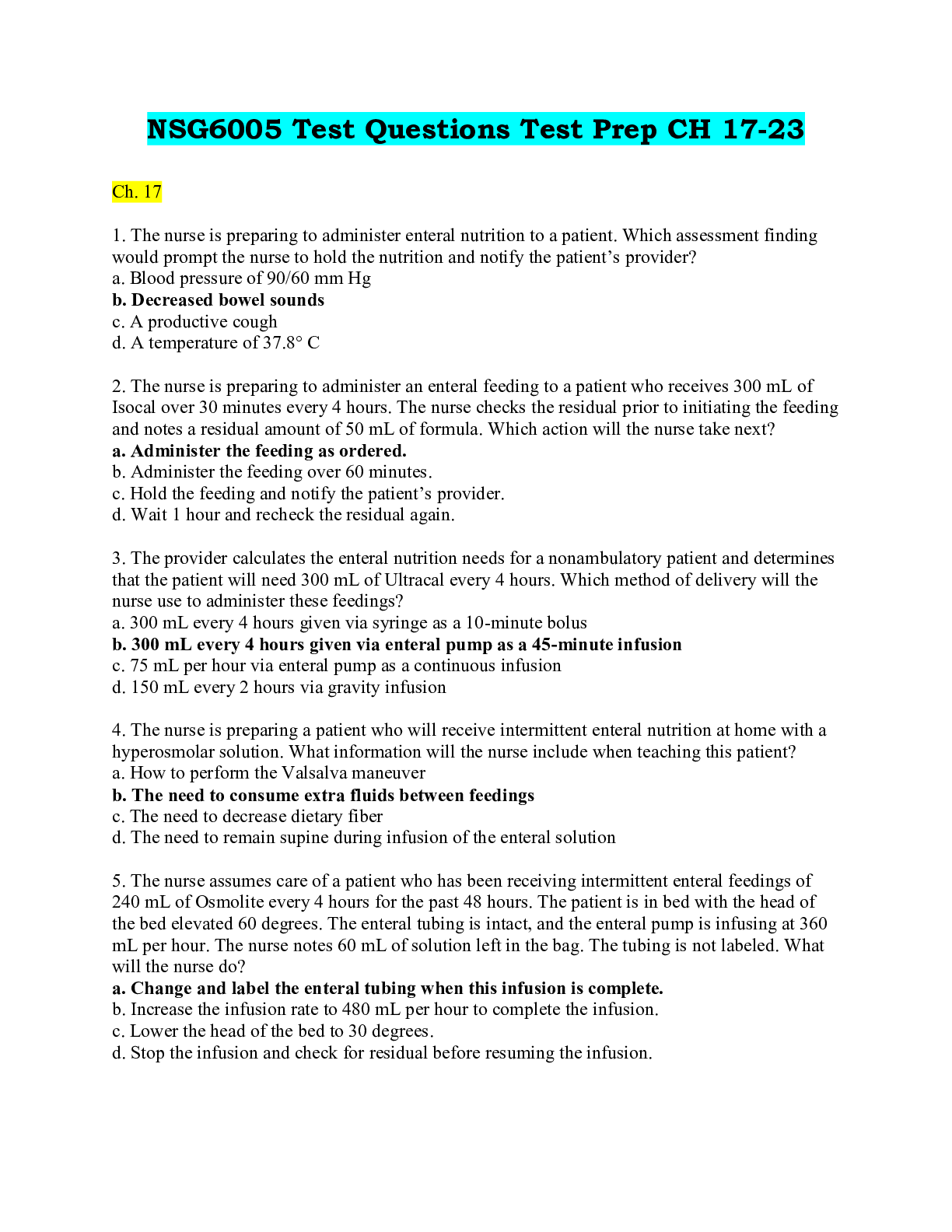
Instant download
Reviews( 0 )
Document information
Connected school, study & course
About the document
Uploaded On
Feb 11, 2021
Number of pages
20
Written in
Additional information
This document has been written for:
Uploaded
Feb 11, 2021
Downloads
0
Views
45

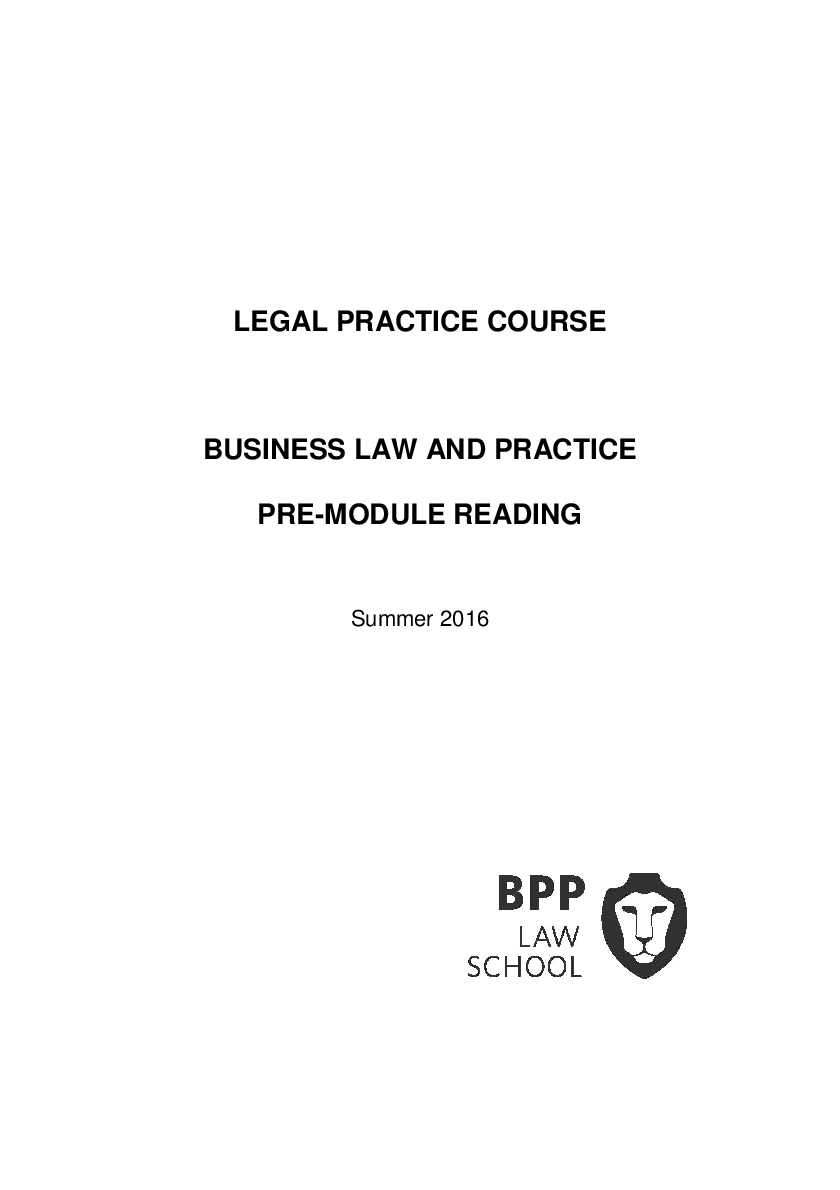
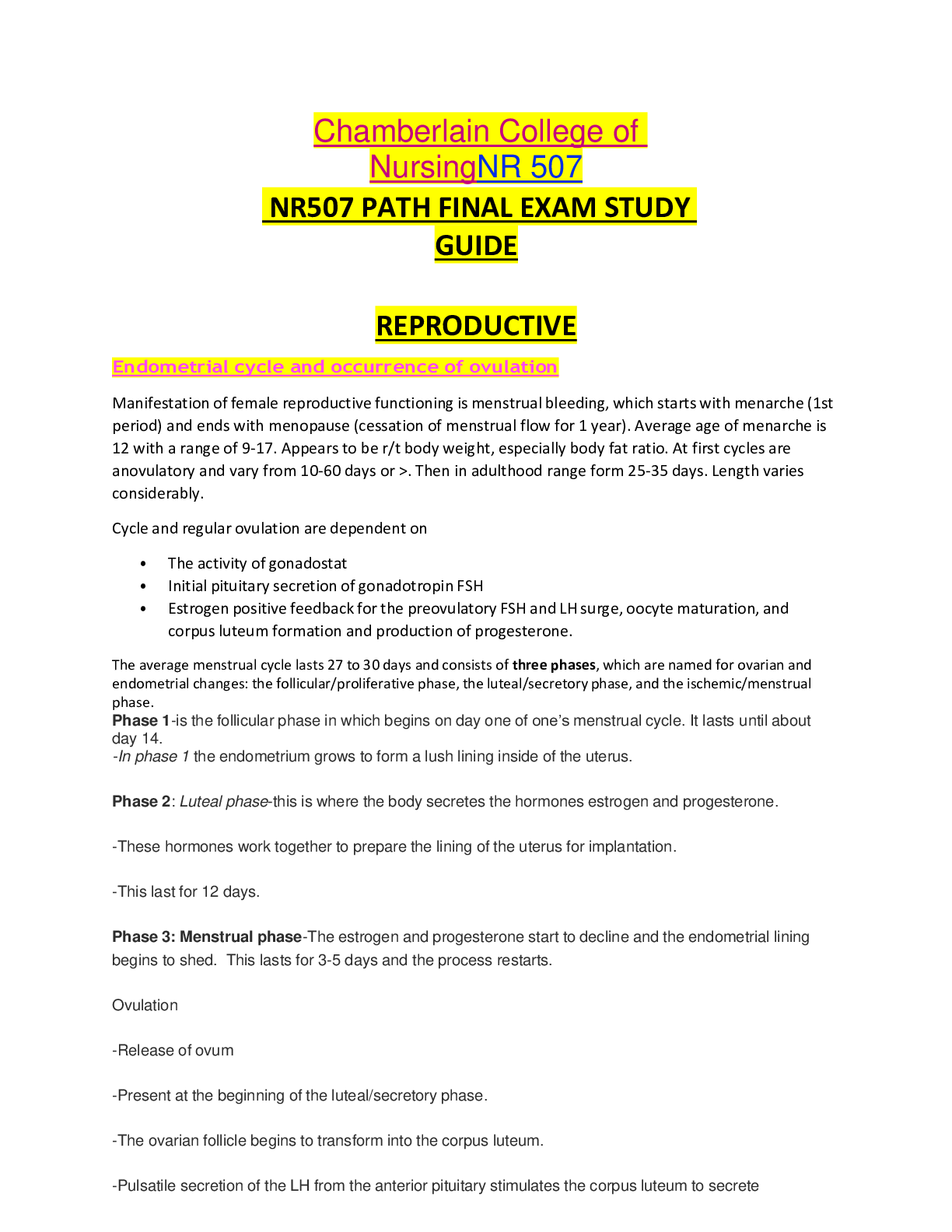

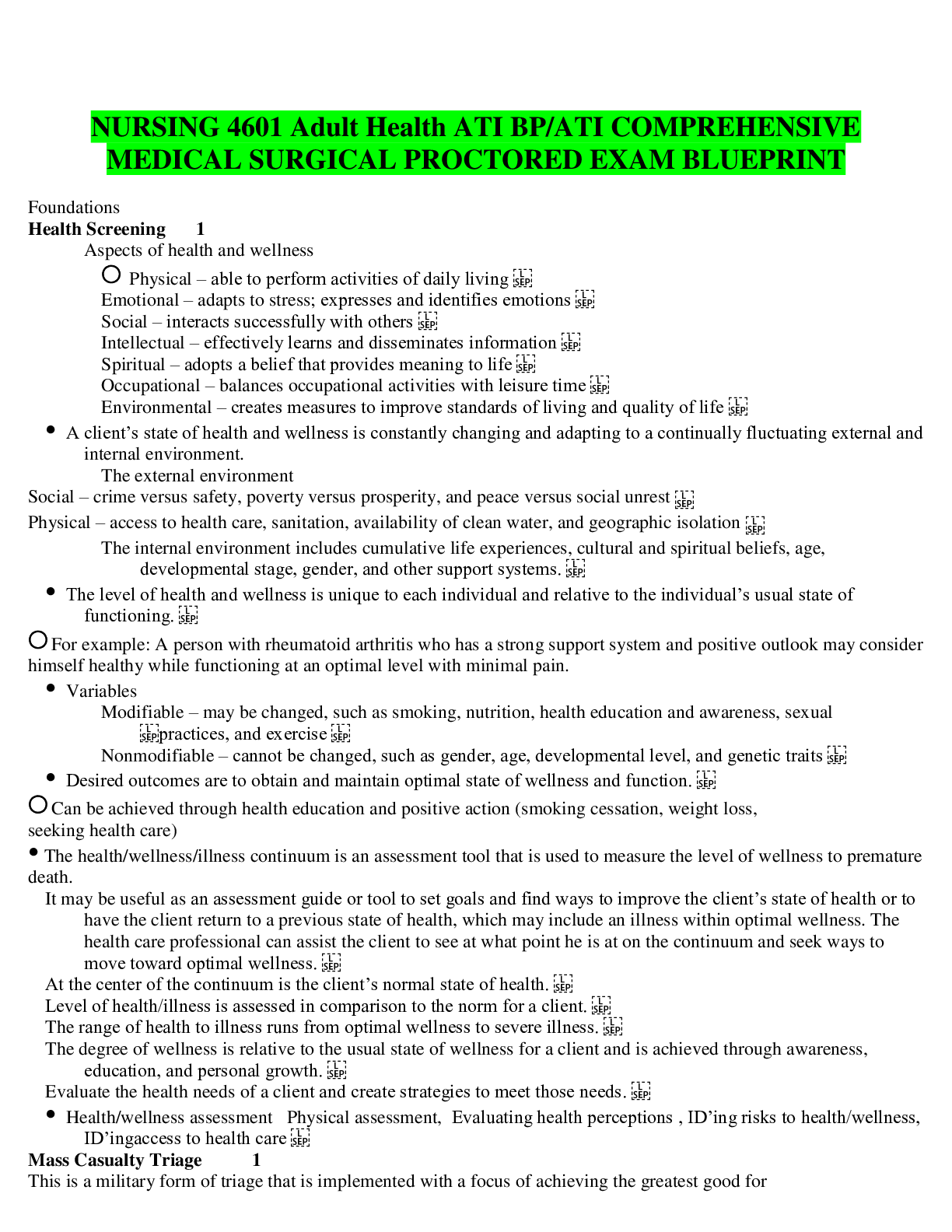
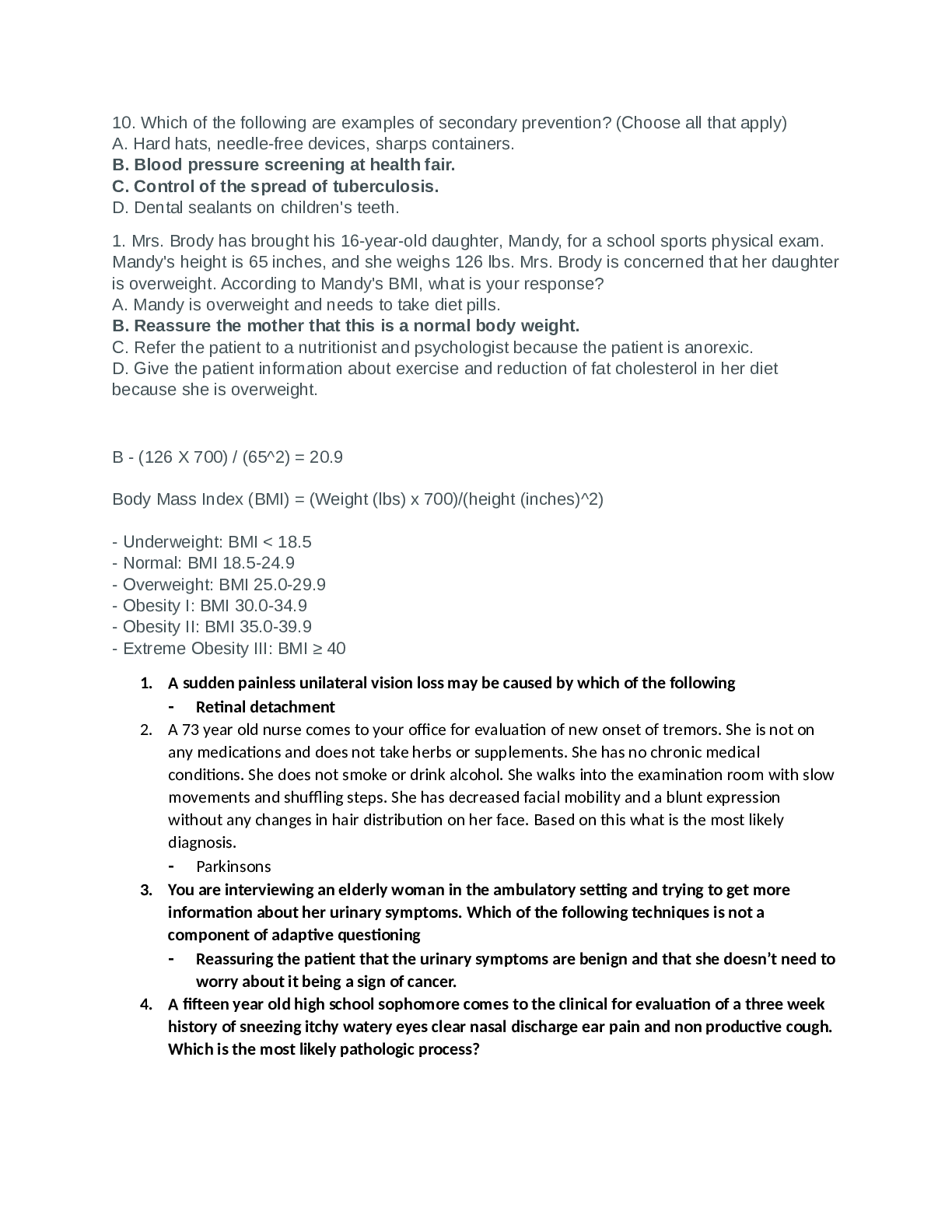

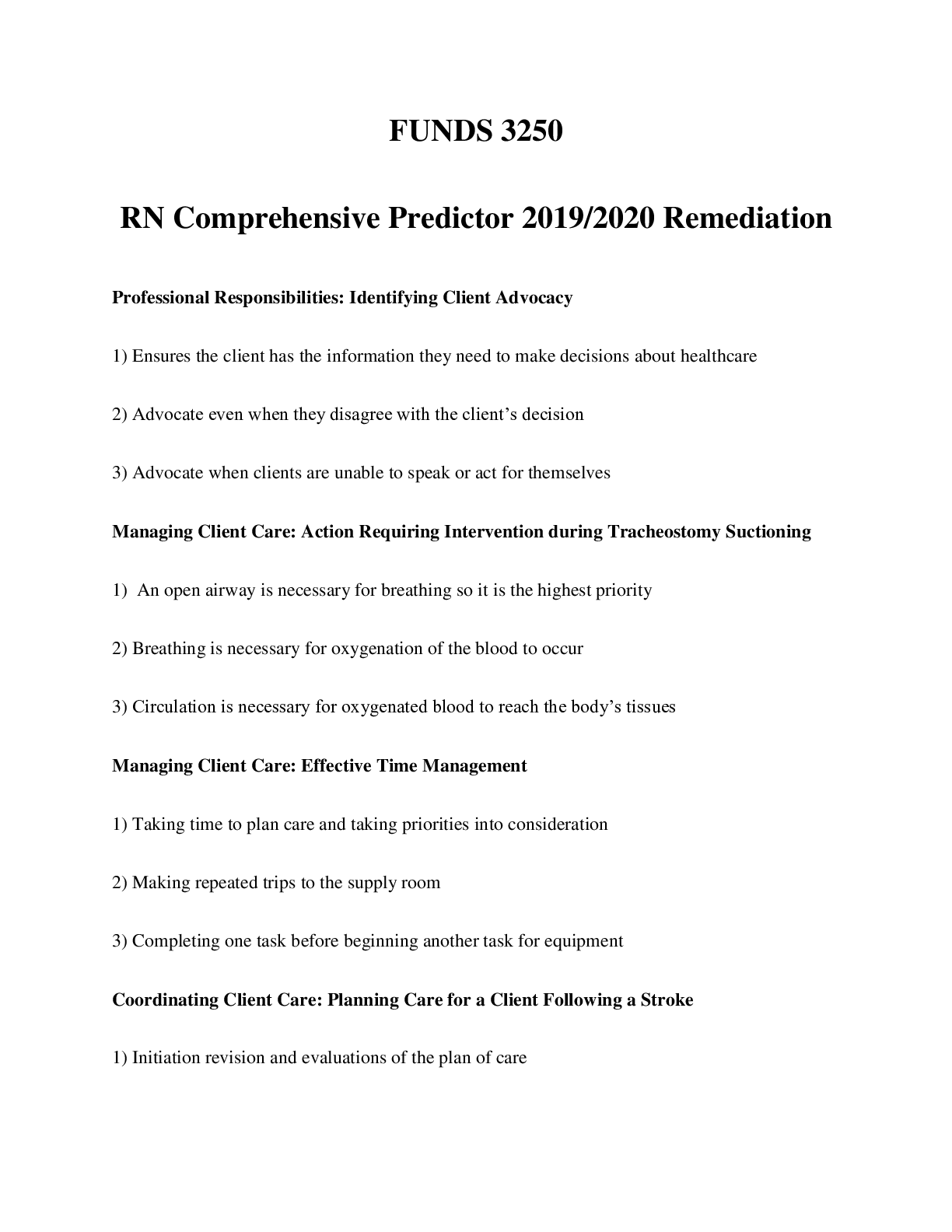

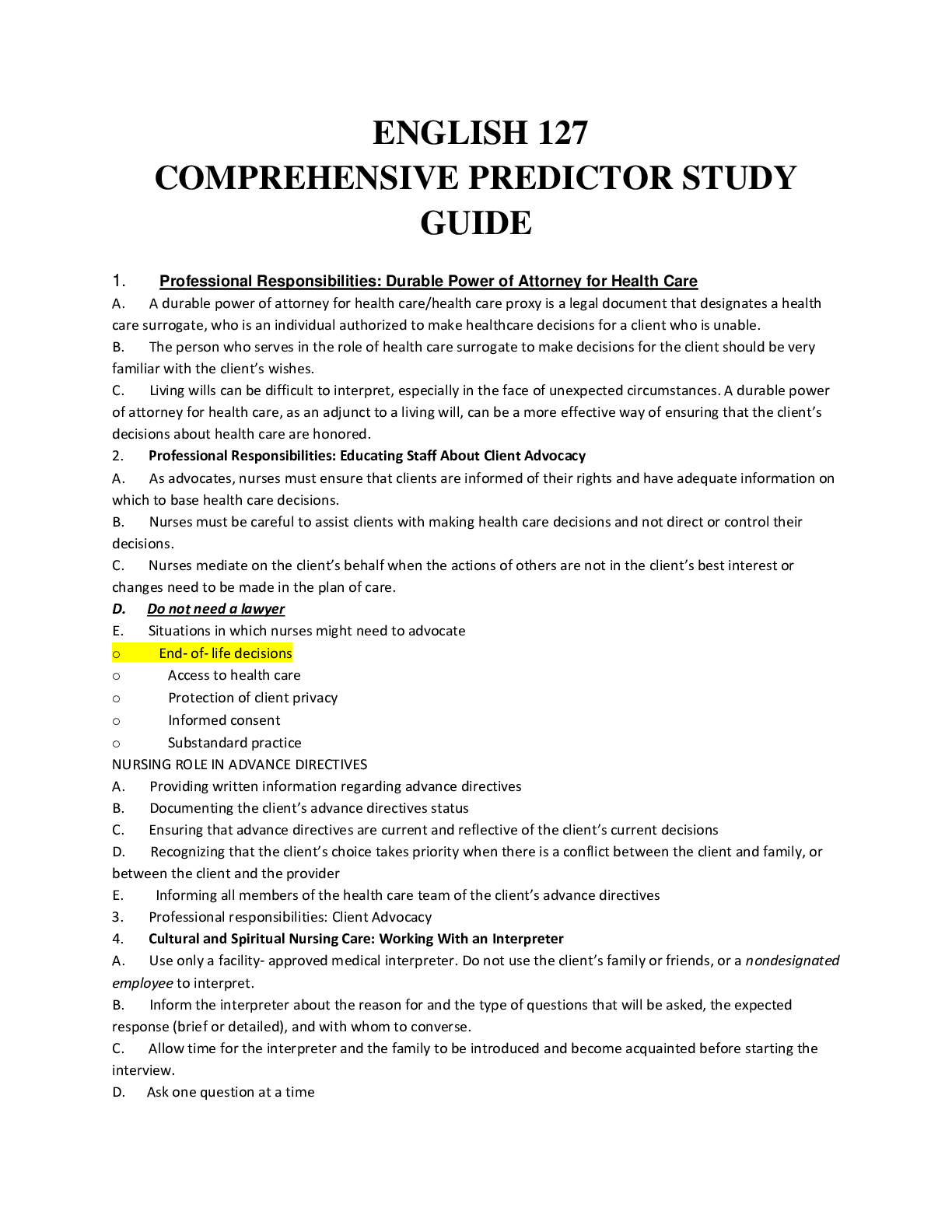
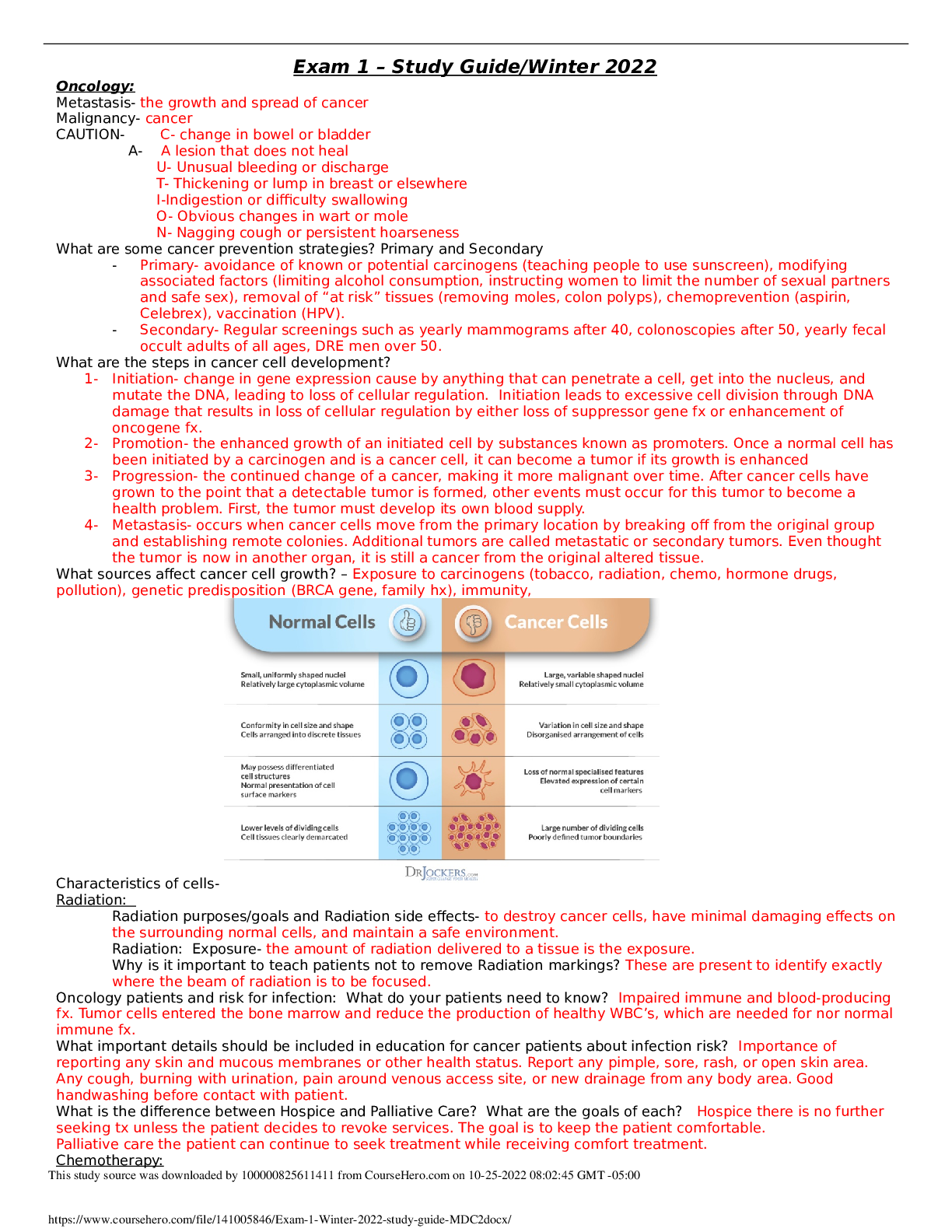
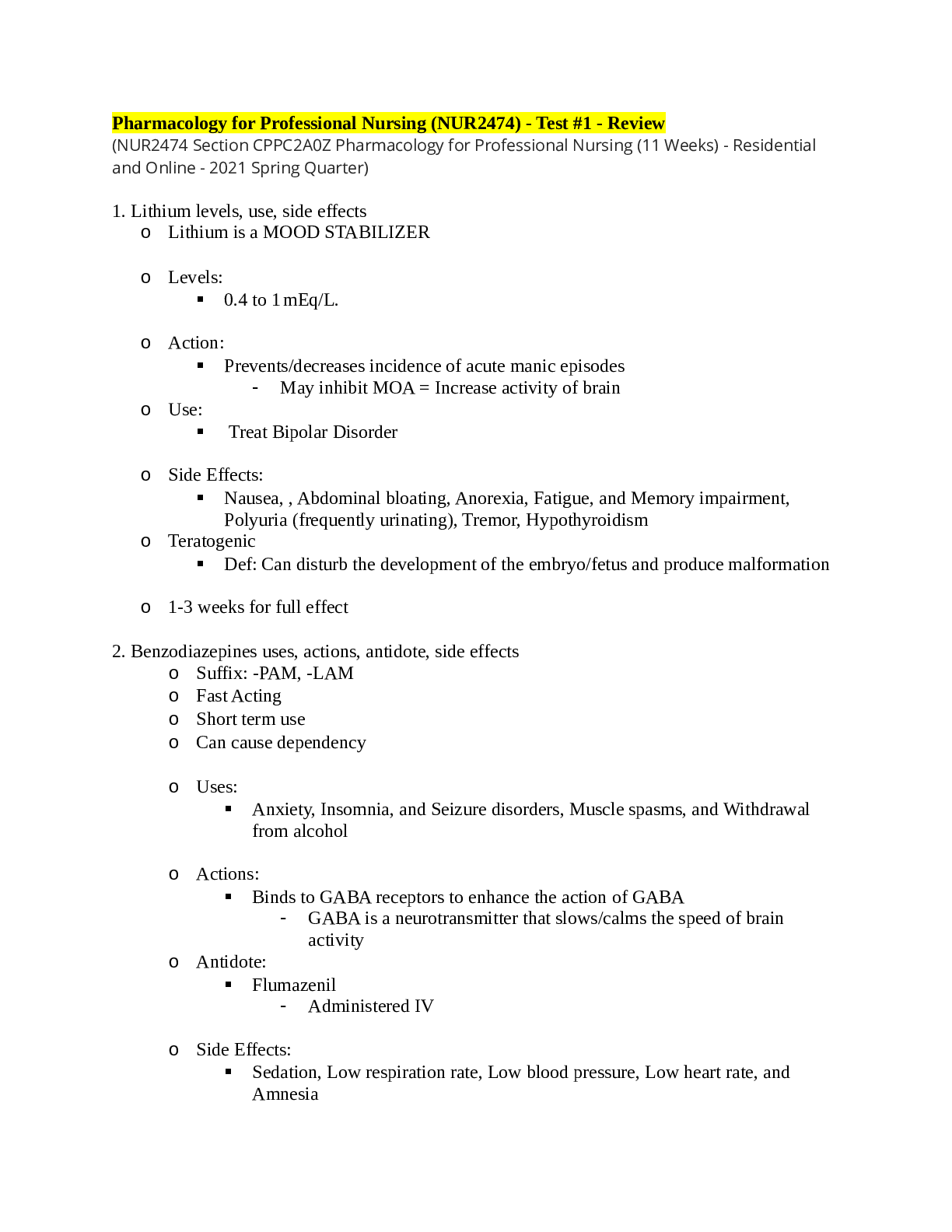
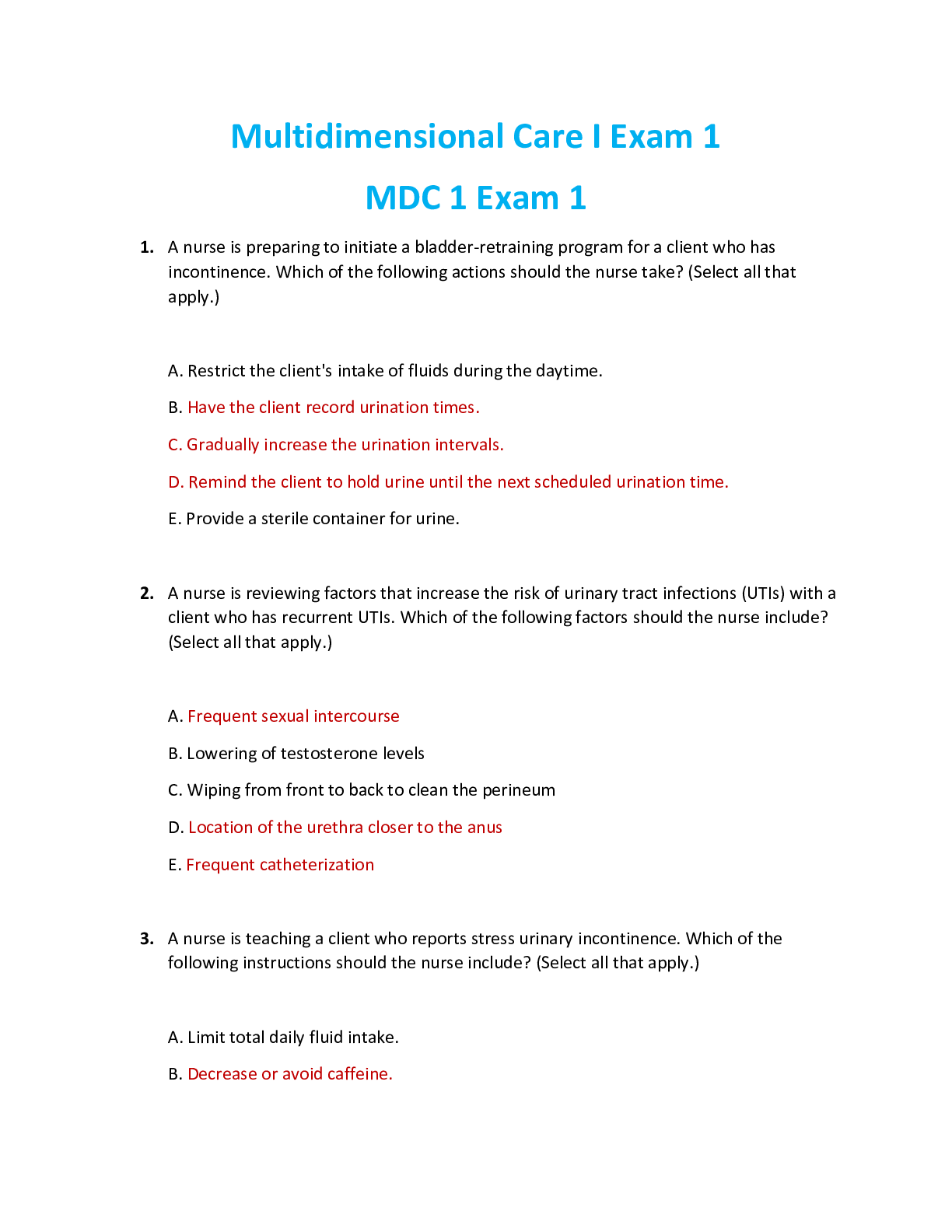
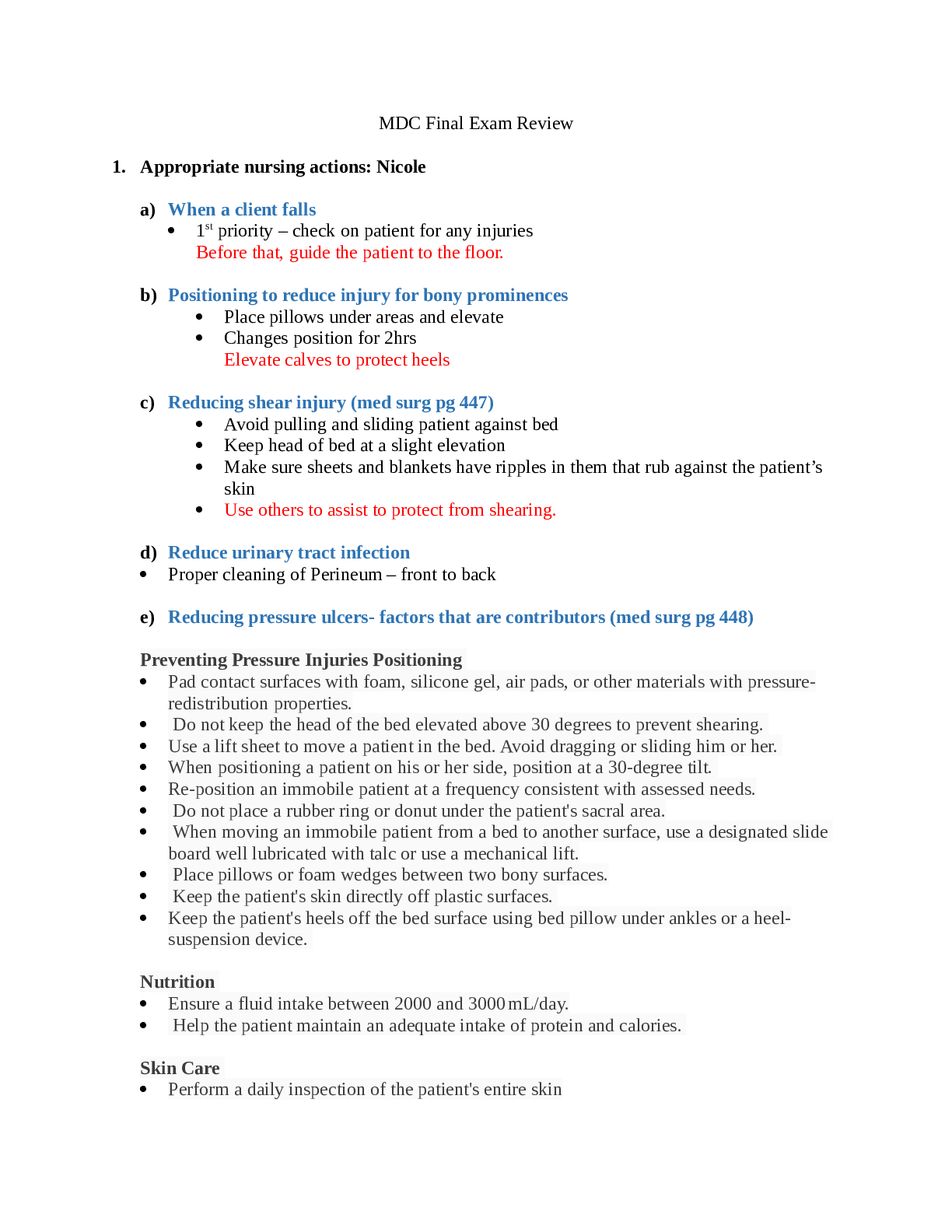
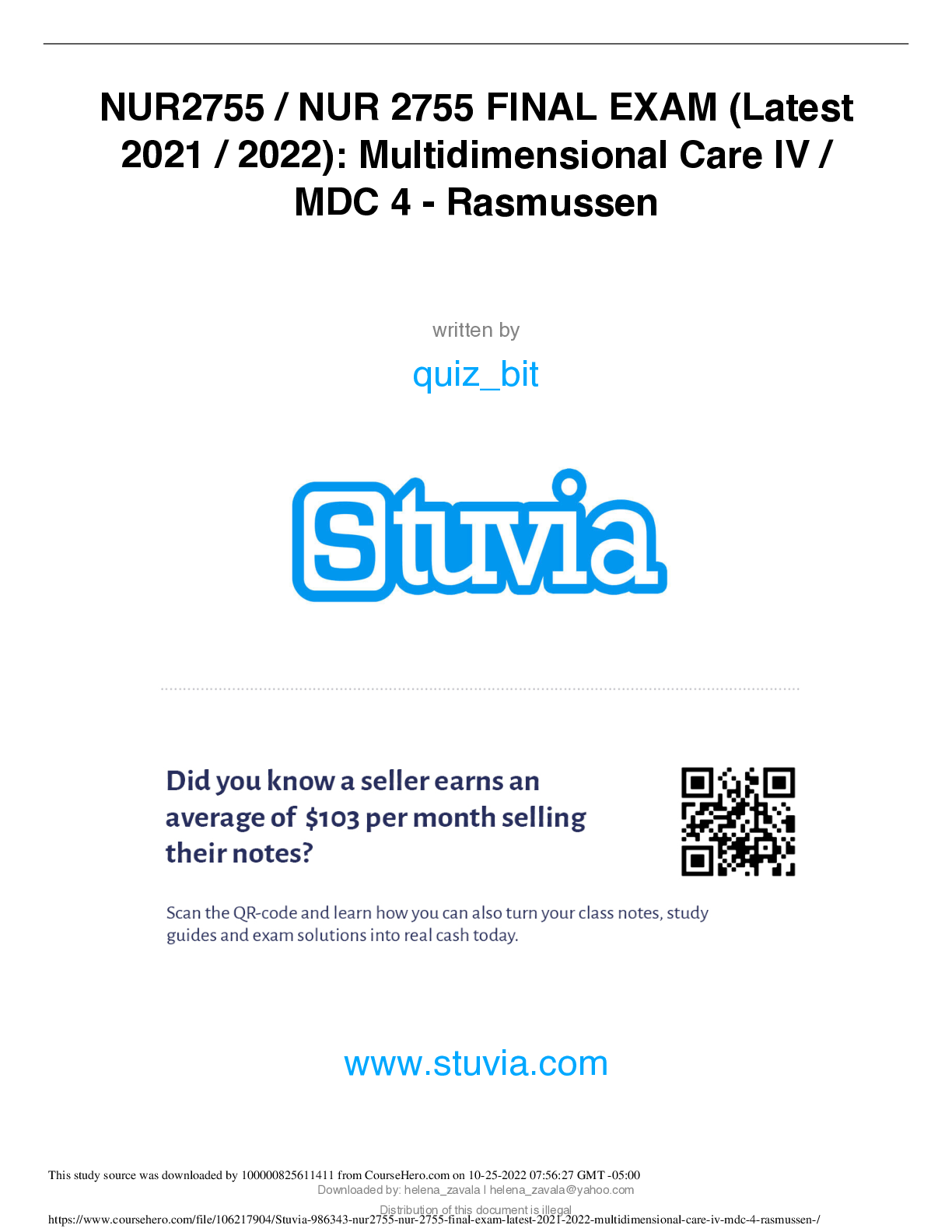
_2nd_E_Completed.png)
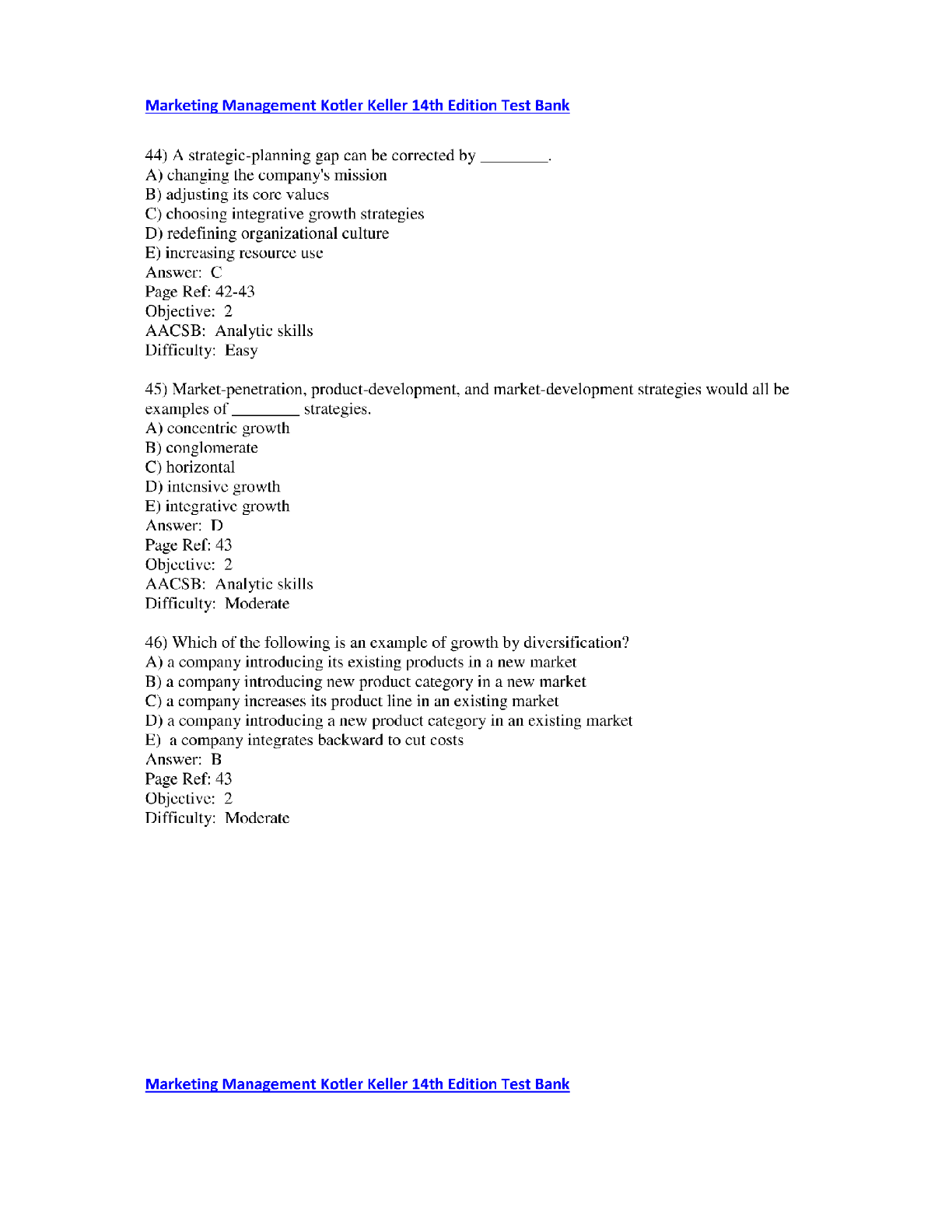
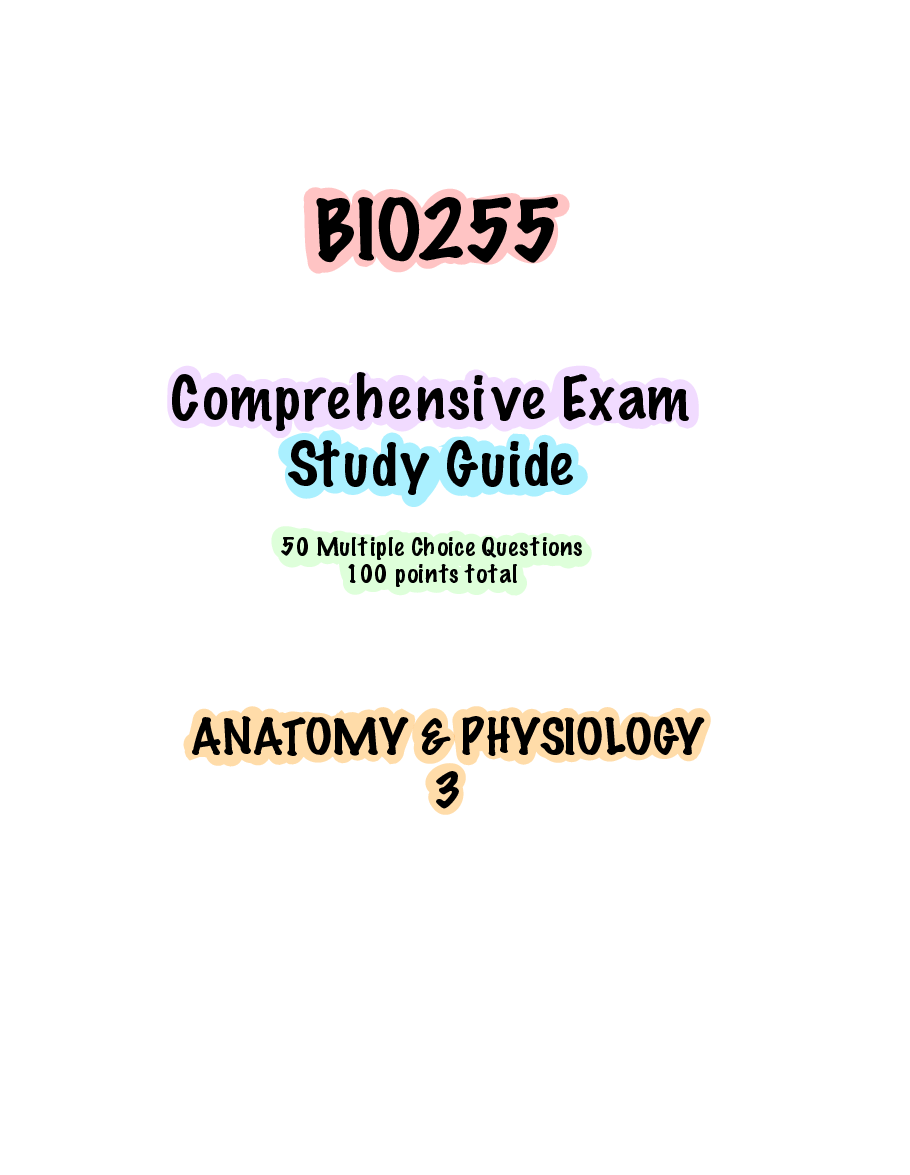

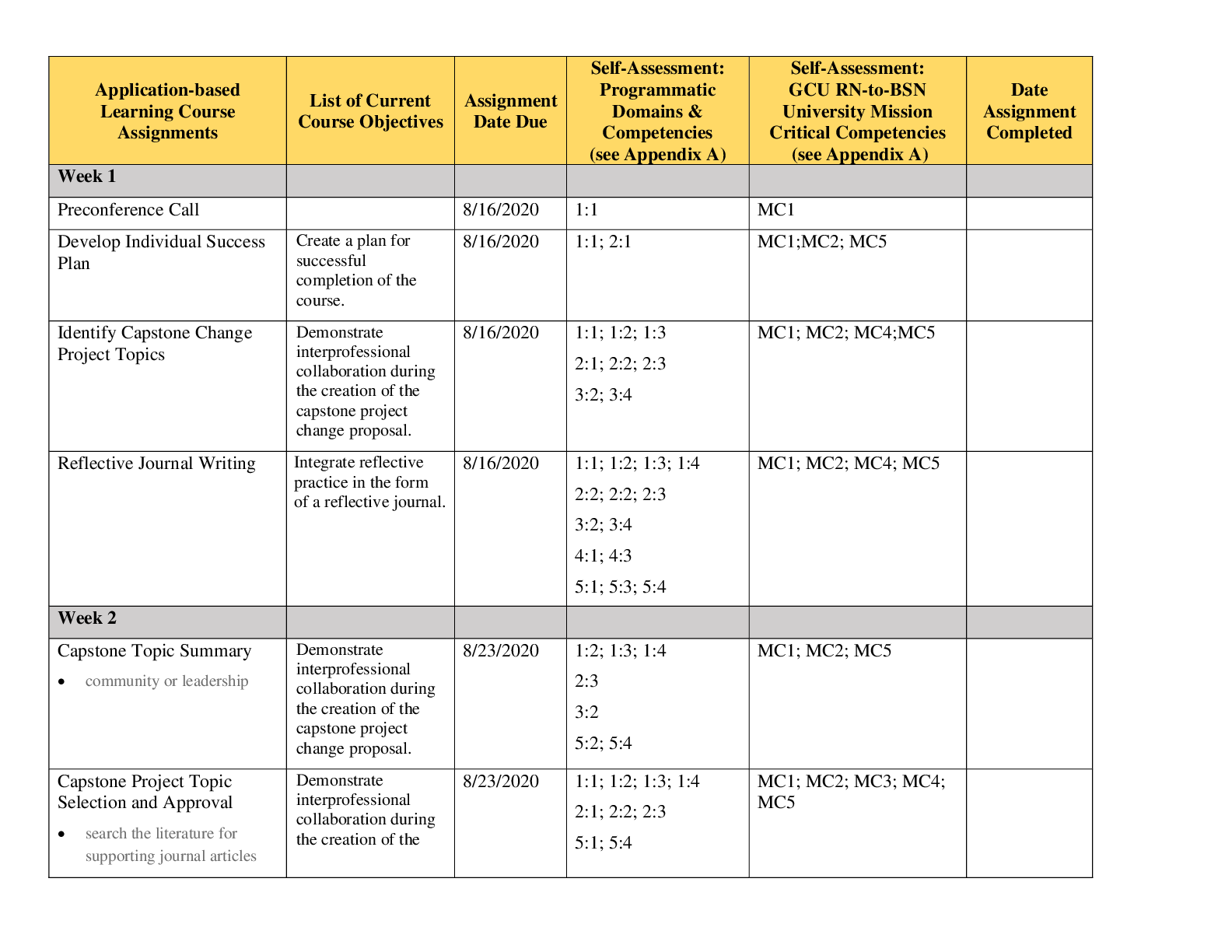






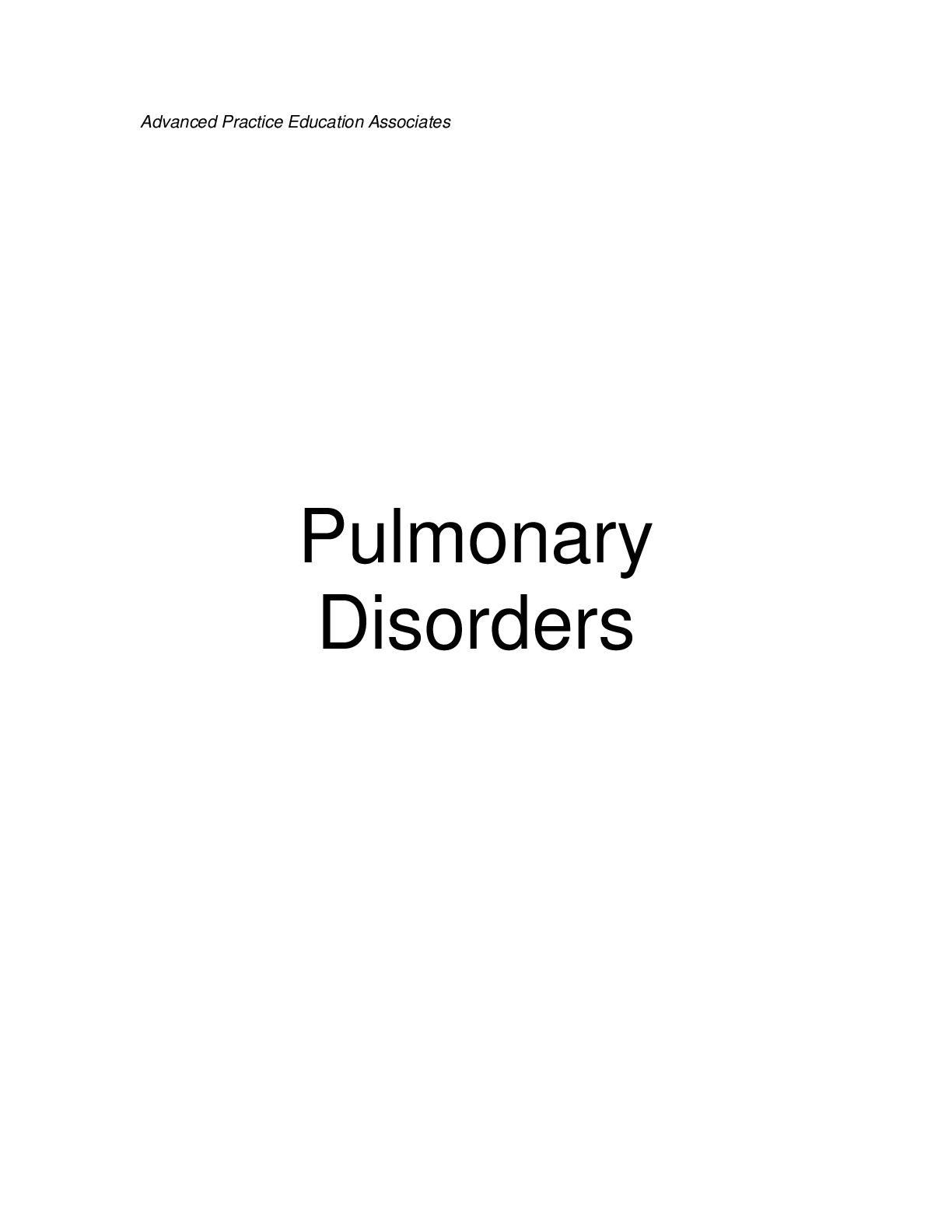
.png)





